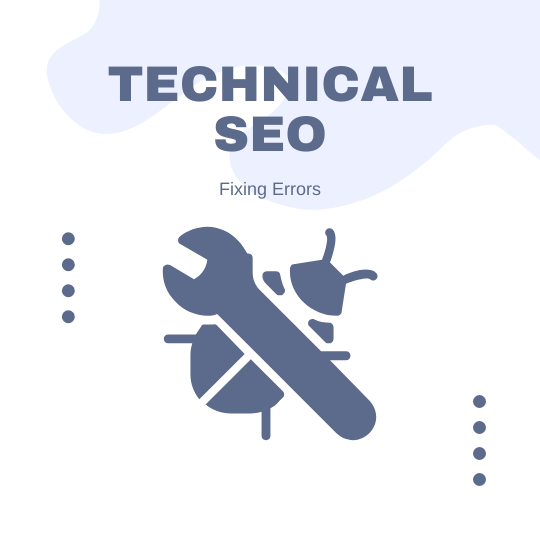Technical SEO – Fixing Errors: Common Issues Solved
Fixing errors is the first step towards boosting your website’s search engine performance. Invisible glitches act like roadblocks, preventing search engines from crawling and understanding your site, burying your valuable content deep in the shadows of search results.
But worry not! Our guide arms you with the expertise and tools needed to pinpoint and rectify these issues. By addressing these obstacles head-on, you’ll pave the path for enhanced visibility, elevated rankings, and a surge in organic traffic.
Embark on this journey through the realm of technical SEO and unlock your website’s full potential as a search engine magnet!

Identifying Common Technical SEO Errors
When diagnosing technical SEO issues, it’s crucial to recognize common errors that can hinder your website’s performance. Here are some key roadblocks to watch out for:
- Broken Links and 404 Errors: Broken links not only disrupt user experience but also signal to search engines that your site may need to be updated or better maintained. Regularly audit your website for broken links and 404 errors using tools like Screaming Frog or Google Search Console.
- Duplicate Content: Duplicate content can confuse search engines and dilute the visibility of your pages. Identify duplicate content issues by comparing URLs and utilizing canonical tags to consolidate ranking signals.
- Slow Page Speed: Page speed is a critical factor for both user experience and search engine rankings. Use tools like Google PageSpeed Insights to assess and optimize your website’s loading times.
- Crawl Errors: Crawl errors occur when search engine bots encounter issues accessing and indexing your site’s pages. Monitor crawl errors in Google Search Console and address them promptly to ensure optimal crawlability.
Fixing Errors: Website Audit Tools
Performing a comprehensive website audit is essential for identifying and addressing technical SEO errors effectively. Here are some powerful tools to include in your arsenal:
- Screaming Frog: This versatile desktop tool allows you to crawl websites and uncover issues such as broken links, duplicate content, and missing meta tags.
- Google Search Console: Google’s free web service provides valuable insights into your site’s performance in search results, including crawl errors, indexing issues, and mobile usability issues.
- SEMrush: SEMrush offers a suite of SEO tools, including site audits, keyword research, and competitive analysis, to help you identify technical SEO issues and optimize your website for better performance.
- GTmetrix: This tool analyzes your website’s page speed performance and provides actionable recommendations for improvement, helping you optimize loading times and enhance user experience.
Understanding Core Web Vitals and Their Impact on Rankings
Core Web Vitals are a set of user-focused metrics that measure aspects of web page experience, including loading performance, interactivity, and visual stability. Understanding and optimizing for Core Web Vitals is essential for improving user experience and maintaining high search engine rankings. Key Core Web Vitals include:
- Cumulative Layout Shift (CLS): Evaluates visual stability by quantifying unexpected layout shifts during page load.
- Largest Contentful Paint (LCP): Measures loading performance by evaluating the time it takes for the largest content element to become visible.
- First Input Delay (FID): Assesses interactivity by measuring the time it takes for a webpage to become interactive and respond to user input.
Fixing the Issues
Navigating the maze of technical SEO challenges requires proactive measures to address and resolve underlying issues. Here’s how to tackle common problems and optimize your website for peak performance:
Conquering Broken Links and Redirects
Imagine someone clicking on a link to your website only to encounter a frustrating “Page Not Found” error. Broken links not only hurt user experience but also need to be clarified for search engines. Here’s how to tame the 404 beast:
- Regularly audit your website for broken links using tools like Screaming Frog or Google Search Console.
- Fix broken links by redirecting them to relevant existing pages using 301 redirects.
- Remove orphaned pages entirely if they serve no purpose.
- Implement proper internal linking practices to avoid broken links in the future.
Ensuring Search Engines Know Your Site’s Structure
Think of your website’s sitemap as a blueprint for search engines. A clear and up-to-date sitemap helps them understand your website’s structure and efficiently crawl all your pages. Here’s how to become a sitemap whiz:
- Generate an XML sitemap using plugins or website builder tools.
- Submit your sitemap to Google Search Console and other search engines.
- Keep your sitemap updated whenever you add new pages or remove old ones.
Optimizing Page Speed
Website speed is crucial for both user experience and search engine ranking. Slow loading times frustrate users and send them to click away, while search engines favor fast-loading websites. Here’s how to turbocharge your site:
- Optimize images using compression tools without sacrificing quality.
- Reduce the size of your CSS and JavaScript files.
- Utilize a Content Delivery Network (CDN) to deliver content faster globally.
- Consider website caching solutions to avoid loading the same resources repeatedly.
Mobile-First Indexing: Making Your Site Shine on All Devices
Today, more people search on mobile devices than desktops. Google prioritizes mobile-friendly websites in search results. Ensure your website shines on all screens with the following:
- A responsive design that adapts to different screen sizes.
- Fast loading times on mobile devices.
- Easy-to-read fonts and clickable buttons.
- Optimized images and videos for mobile viewing.
Structured Data: Speaking the Language of Search Engines
Think of structured data as rich information snippets you provide to search engines. It helps them understand the content on your pages better and display it more informatively in search results. Here’s how to speak the language of search engines:
- Implement schema markup for different types of content like articles, products, and events.
- Use Google’s Structured Data Testing Tool to validate your implementation.
- Clearly present structured data without affecting user experience.
Optimizing for Success
Fixing technical errors is a big step in the right direction, but the SEO journey continues. Let’s explore how to sustain and amplify your success:
Beyond Fixing Errors
Think of technical SEO as the foundation of your website’s SEO house. While fixing errors is crucial, maintaining its health requires ongoing efforts. Here’s how to prevent future issues:
- Schedule regular website audits to catch new errors before they impact your site.
- Stay updated on Google’s algorithm changes and adapt your SEO strategy accordingly.
- Continuously monitor and improve your website’s core web vitals.
- Invest in quality content creation and link building for long-term growth.
Tracking the Results of Your SEO Efforts
Data is your friend in SEO! Tracking your progress helps you understand what’s working and identify areas for improvement. Here’s how to measure your success:
- Monitor important metrics like organic traffic, keyword rankings, and website conversions.
- Utilize tools like Google Search Console, Google Analytics, and SEO tracking software.
- Set clear goals and track your progress over time to see how your SEO efforts are paying off.
- Analyze your data regularly and adjust your strategy as needed.
Fixing Errors – Conclusion
Congratulations! You’ve tackled technical SEO errors, optimized your site, and laid the foundation for success. But remember, SEO is a journey, not a destination. By embracing ongoing maintenance, data-driven insights, and quality content creation, you can:
- Attract more visitors: Higher rankings and improved user experience will draw them in.
- Convert them into customers: A smooth, optimized site turns visits into leads and sales.
- Become an authority: Valuable content positions you as an industry leader.
Remember, it’s a continuous process, but with commitment and effort, you can transform your website from a hidden gem to a thriving online presence. So, keep learning, experimenting, and optimizing – the best is yet to come!



The blog is well-researched, informative, and actionable, providing readers with practical guidance on identifying and fixing technical SEO issues to improve website performance and search engine rankings.
Learning about technical SEO is important for making websites better. Your guide will definitely help me fix mistakes so more people can find my website. I will start fixing errors and making my website better today! Thank you so much Maya